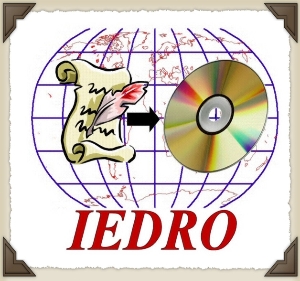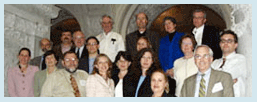The preservation of digital records is on the mind of the average person more with each passing day. Consider the video below from the recent BBC article Warning of data ticking time bomb.
Microsoft UK Managing Director Gordon Frazer running Windows 3.1 on a Vista PC
(Watch video in the BBC News Player)
The video discusses Microsoft’s Virtual PC program that permits you to run multiple operating systems via a Virtual Console. This is an example of the emulation approach to ensuring access to old digital objects – and it seems to be done in a way that the average user can get their head around. Since a big part of digital preservation is ensuring you can do something beyond reading the 1s and 0s – it is promising step. It also pleased me that they specifically mention the UK National Archives and how important it is to them that they can view documents as they originally appeared – not ‘converted’ in any way.
Dorthea Salo of Caveat Lector recently posted Hello? Is it me you’re looking for?. She has a lot to say about digital curation , IR (which I took to stand for Information Repositories rather than Information Retrieval) and librarianship. Coming, as I do, from the software development and database corners of the world I was pleased to find someone else who sees a gap between the standard assumed roles of librarians and archivists and the reality of how well suited librarians’ and archivists’ skills are to “long-term preservation of information for use” – be it digital or analog.
I skimmed through the 65 page Joint Information Systems Committee (JISC) report Dorthea mentioned (Dealing with data: Roles, rights, responsibilities and relationships). A search on the term ‘archives’ took me to this passage on page 22:
There is a view that so-called “dark archives” (archives that are either completely inaccessible to users or have very limited user access), are not ideal because if data are corrupted over time, this is not realised until point of use. (emphasis added)
For those acquainted with software development, the term regression testing should be familiar. It involves the creation of automated suites of test programs that ensure that as new features are added to software, the features you believe are complete keep on working. This was the first idea that came to my mind when reading the passage above. How do you do regression testing on a dark archive? And thinking about regression testing, digital preservation and dark archives fueled a fresh curiosity about what existing projects are doing to automate the validation of digital preservation.
A bit of Googling found me the UK National Archives requirements document for The Seamless Flow Preservation and Maintenance Project. They list regression testing as a ‘desirable’ requirement in the Statement of Requirements for Preservation and Maintenance Project Digital Object Store (defined as “those that should be included, but possibly as part of a later phase of development”). Of course it is very hard to tell if this regression testing is for the software tools they are building or for access to the data itself. I would bet the former.
Next I found my way to the website for LOCKSS (Lots of Copies Keep Stuff Safe). While their goals relate to the preservation of electronically published scholarly assets’ on the web, their approach to ensuring the validity of their data over time should be interesting to anyone thinking about long term digital preservation.
In the paper Preserving Peer Replicas By RateLimited Sampled Voting they share details of how they manage validation and repair of the data they store in their peer-to-peer architecture. I was bemused by the categories and subject descriptors assigned to the paper itself: H.3.7 [Information Storage and Retrieval]: Digital Libraries; D.4.5 [Operating Systems]: Reliability . Nothing about preservation or archives.
It is also interesting to note that you can view most of the original presentation at the 19th ACM Symposium on Operating Systems Principles (SOSP 2003) from a video archive of webcasts of the conference. The presentation of the LOCKSS paper begins about halfway through the 2nd video on the video archive page .
The start of the section on design principles explains:
Digital preservation systems have some unusual features. First, such systems must be very cheap to build and maintain, which precludes high-performance hardware such as RAID, or complicated administration. Second, they need not operate quickly. Their purpose is to prevent rather than expedite change to data. Third, they must function properly for decades, without central control and despite possible interference from attackers or catastrophic failures of storage media such as fire or theft.
Later they declare the core of their approach as “..replicate all persistent storage across peers, audit replicas regularly and repair any damage they find.” The paper itself has lots of details about HOW they do this – but for the purpose of this post I was more interested in their general philosophy on how to maintain the information in their care.
DAITSS (Dark Archive in the Sunshine State) was built by the Florida Center for Library Automation (FCLA) to support their own needs when creating the Florida Center for Library Automation Digital Archive (Florida Digital Archive or FDA). In mid May of 2007, FCLA announced the release of DAITSS as open source software under the GPL license.
In the document The Florida Digital Archive and DAITSS: A Working Preservation Repository Based on Format Migration I found:
… the [Florida Digital Archive] is configured to write three copies of each file in the [Archival Information Package] to tape. Two copies are written locally to a robotic tape unit, and one copy is written in real time over the Internet to a similar tape unit in Tallahassee, about 130 miles away. The software is written in such a way that all three writes must complete before processing can continue.
Similar to LOCKSS, DAITSS relies on what they term ‘multiple masters’. There is no concept of a single master. Since all three are written virtually simultaneously they are all equal in authority. I think it is very interesting that they rely on writing to tapes. There was a mention that it is cheaper – yet due to many issues they might still switch to hard drives.
With regard to formats and ensuring accessibility, the same document quoted above states on page 2:
Since most content was expected to be documentary (image, text, audio and video) as opposed to executable (software, games, learning modules), FCLA decided to implement preservation strategies based on reformatting rather than emulation….Full preservation treatment is available for twelve different file formats: AIFF, AVI, JPEG, JP2, JPX, PDF, plain text, QuickTime, TIFF, WAVE, XML and XML DTD.
The design of DAITSS was based on the Reference Model for an Open Archival Information System (OAIS). I love this paragraph from page 10 of the formal specifications for OAIS adopted as ISO 14721:2002.
The information being maintained has been deemed to need Long Term Preservation, even if the OAIS itself is not permanent. Long Term is long enough to be concerned with the impacts of changing technologies, including support for new media and data formats, or with a changing user community. Long Term may extend indefinitely. (emphasis added)
Another project implementing the OAIS reference model is CASPAR – Cultural, Artistic and Scientific knowledge for Preservation, Access and Retrieval. This project appears much greater in scale than DAITSS. It started a bit more than 1 year ago (April 1, 2006) with a projected duration of 42 months, 17 partners and a projected budget of 16 million Euros (roughly 22 million US Dollars at the time of writing). Their publications section looks like it could sidetrack me for weeks! On page 25 of the CASPAR Description of Work, in a section labeled Validation, a distinction is made between “here and now validation” and “the more fundamental validation techniques on behalf of the ‘not yet born'”. What eloquent turns of phrase!
Page 7 found me another great tidbit in a list of digital preservation metrics that are expected:
2) Provide a practical demonstration by means of what may be regarded as “accelerated lifetime” tests. These should involve demonstrating the ability of the Framework and digital information to survive:
a. environment (including software, hardware) changes: Demonstration to the External Review Committee of usability of a variety of digitally encoded information despite changes in hardware and software of user systems, and such processes as format migration for, for example, digital science data, documents and music
b. changes in the Designated Communities and their Knowledge Bases: Demonstration to the External Review Committee of usability of a variety of digitally encoded information by users of different disciplines
Here we have thought not only about the technicalities of how users may access the objects in the future, but consideration of users who might not have the frame of reference or understanding of the original community responsible for creating the object. I haven’t seen any explicit discussion of this notion before – at least not beyond the basic idea of needing good documentation and contextual background to support understanding of data sets in the future. I love the phrase ‘accelerated lifetime’ but I wonder how good a job we can do at creating tests for technology that does not yet exist (consider the Ladies Home Journal predictions for the year 2000 published in 1900).
What I love about LOCKSS, DAITSS and CASPAR (and no, it isn’t their fabulous acronyms) is the very diverse groups of enthusiastic people trying to do the right thing. I see many technical and research oriented organizations listed as members of the CASPAR Consortium – but I also see the Università degli studi di Urbino (noted as “created in 1998 to co-ordinate all the research and educational activities within the University of Urbino in the area of archival and library heritage, with specific reference to the creation, access, and preservation of the documentary heritage”) and the Humanities Advanced Technology and Information Institute, University of Glasgow (noted as having “developed a cutting edge research programme in humanities computing, digitisation, digital curation and preservation, and archives and records management”). LOCKSS and DAITSS have both evolved in library settings.
Questions relating to digital archives, preservation and validation are hard ones. New problems and new tools (like Microsoft’s Virtual PC shown in the video above) are appearing all the time. Developing best practices to support real world solutions will require the combined attention of those with the skills of librarians, archivists, technologists, subject matter specialists and others whose help we haven’t yet realized we need. The challenge will be to find those who have experience in multiple areas and pull them into the mix. Rather than assuming that one group or another is the best choice to solve digital preservation problems, we need to remember there are scores of problems – most of which we haven’t even confronted yet. I vote for cross pollination of knowledge and ideas rather than territorialism. I vote for doing your best to solve the problems you find in your corner of the world. There are more than enough hard questions to answer to keep everyone who has the slightest inclination to work on these issues busy for years. I would hate to think that any of those who want to contribute might have to spend energy to convince people that they have the ‘right’ skills. Worse still – many who have unique viewpoints might not be asked to share their perspectives because of general assumptions about the ‘kind’ of people needed to solve these problems. Projects like CASPAR give me hope that there are more examples of great teamwork than there are of people being left out of the action.
There is so much more to read, process and understand. Know of a digital preservation project with a unique approach to validation that I missed? Please contact me or post a comment below.




